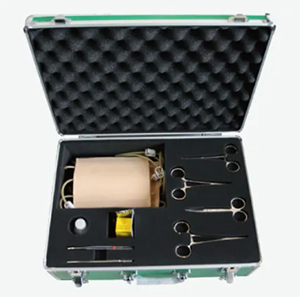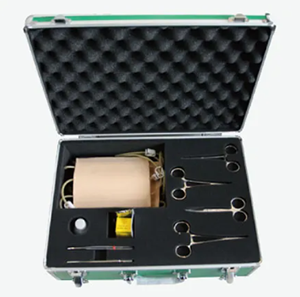Vascular ligation technology plays a vital role in surgical procedures, especially in cases where bleeding needs to be controlled during trauma or surgery. Mastering this technique is essential for the skill development of medical students and clinical surgeons. However, the complexity of the vascular ligation operation and the high demand for skills make many beginners prone to mistakes in the actual operation. Fortunately, with the advancement of simulation training equipment, the surface vessel ligation hemostasis model has become an effective training tool. It can not only improve the operational accuracy of students, but also accelerate the transition from theory to practice, especially in the mastery of skills for beginners.
How to help students quickly master the technology

Surface vessel ligation hemostatic model
The surface vessel ligation hemostasis model helps trainees train without actual risk by providing a near-realistic clinical environment. For students, the "sense of reality" of the model is the key. It not only simulates the shape of blood vessels and the touch of the skin, but also simulates blood vessel bleeding, allowing students to face a variety of different situations in actual operation. Through this training, participants can gradually develop an intuitive understanding of vascular structure and ligation techniques, which is extremely valuable in real surgery.
With the help of the surface vessel ligation hemostasis model, students can master the precision of the operation through repeated practice, especially in the positioning of blood vessels and the strength control of the ligation operation. It is this hands-on simulation training that enables the trainees to practice with more confidence. For medical students who are new to the technology, model training is a low-risk, high-performing way to learn and help them correct deficiencies in their operations early on.
Data support
According to several studies and industry reports, simulation training plays an increasingly prominent role in medical education. In the case of vascular ligation, for example, a study published in the Journal of Surgical Education showed that participants who trained using a simulation model had about a 30% better success rate in the procedure than those who relied solely on traditional explanations. In addition, the skills gained in the model training can not only be consolidated in the simulation environment, but also be effectively translated into the actual operation. Especially in the simulation process, the students can operate repeatedly under the guidance of the instructor, which significantly reduces the error rate in the actual operation.
What industry experts think
Surgical experts generally agree on the value of simulation training. Professor Li ** (pseudonym), a senior expert in surgical education for many years, said: "The appearance of the surface vessel ligation hemostasis model provides an almost real training environment for students, which can help them quickly master the ligation skills, and reduce the tension and operational errors in clinical surgery."
He further pointed out that through the simulation training, the trainees will not only master the ligation technique, but also train in the simulation model how to react quickly in an emergency situation, which is essential for practical operation. Simulation equipment makes the learning process more personalized, and students can gradually improve their ability to perform complex operations while mastering their own skills.
conclusion
In general, the surface vessel ligation hemostasis model undoubtedly provides a valuable training platform for students. Through repeated simulation exercises, students are able to improve operational accuracy in a low-risk environment and gradually accumulate practical operational experience. Data and feedback from industry experts show that this simulation training can significantly shorten the transition from theory to practice and greatly improve the success rate of operations. Therefore, the surface vessel ligation hemostasis model has become an indispensable tool in surgical education and clinical training, and is worthy of wide application by every medical student and surgeon

